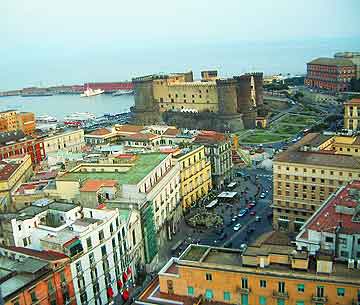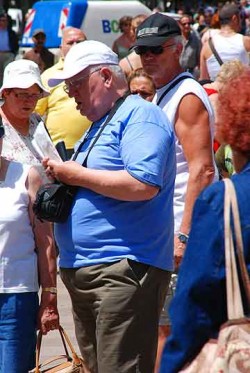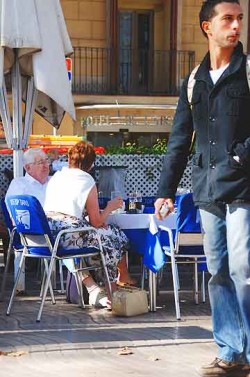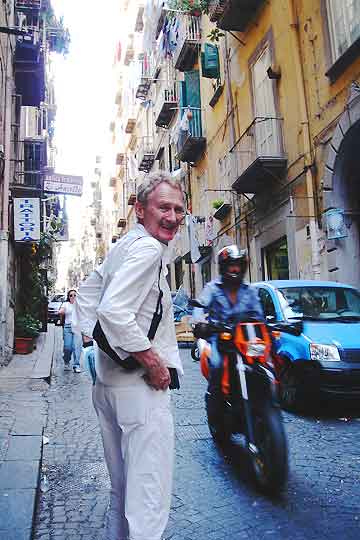
I wonder if Bob and I should have bodyguards, like Roberto Saviano does. We, like Saviano, write about and expose the Camorra, Naples’ infamous mafia. The Camorra is not a crime family to fool with. If they don’t like you, they just kill you. Even if they do like you, because you’re just a tourist with money to spend (or have stolen), you might step in front of a flying bullet. These things happen in Naples.
Robert Saviano wrote the book Gomorrah, about the Camorra, in 2007. It’s been made into a film, which opens in the U.S. this week. Since publishing his book, Saviano has been housebound, despite living with a security detail. “I have not been able to go for a walk, go to a bookstore, to the cinema, to the theatre. Or even just grocery shopping,” he told The Wall Street Journal.
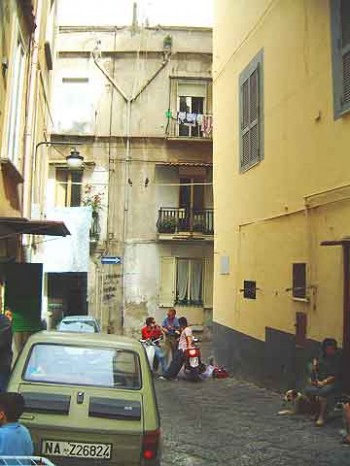
As thiefhunters, Bob and I have been mixing with the criminal element in Naples since 1993. I don’t remember how much we knew about the Camorra in the beginning of our research there. We knew a little, for sure, but not how ruthless they are, not how deep their tentacles reach. We should have been more scared. I mean, on our very first visit we got mugged. That experience left a lasting legacy with me: I still get a chill every time I hear motor-scooter buzzing behind me.
My scientifically-unfounded assumption is that pickpockets in Naples are low-level Camorra members. They steal right in front of police officers, who are also in on the game. About young gang members, a local says “they steal for money,” and “they shoot like it’s a video game.” In Naples, everyone’s part of the system. If higher-ups get word that we’re in town, will they be intrigued and want to talk? Might they show up at our door and threaten us? Will our rooms be broken into and equipment stolen? Will we be mugged again? A bone or two broken, just so we get the message? Am I a hysteric with a rich imagination? The truth is, Naples is dangerous. Not too dangerous for the ordinary visitor, but what about one who goes snooping about in mafia business? One who wants to expose the city’s dirty little secrets?
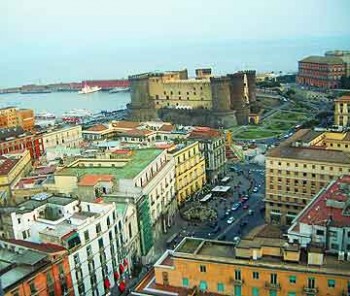
The Camorra
In Naples, everything is connected to the syndicate. Even if you’re not part of it, you pay up. In Rome, we met the owner of a men’s clothing store who told us how her Naples shop was destroyed and how they were extorted and threatened there until they closed up shop and fled to Rome. She cried as she told us this.
Shopkeepers in Naples pay about €1,000 ($1,300) a month as “protection;” supermarket managers pay about €3,000 a month. A report by the Italian retailers’ association Confesercenti, published last week, said organized crime had become Italy’s biggest industry.
The Confesercenti report estimated that organised crime groups take in 30 billion [euros] a year from the protection racket alone, a phenomenon that affects 160,000 businesses or 20% of all shops in Italy.
The extortion plague is particularly prevalent in the south. In the Sicilian towns of Palermo and Catania 80% of shops pay protection money. The figure slips to 70% across the water in Reggio Calabria and to 50% in Naples, although in some of the rundown suburbs of that city absolutely everyone pays.
Quartieri Spagnoli would be one of those rundown suburbs.
Another form of thievery in Naples is Rolex theft. It happens to any non-mafia member who dares to flash the easily identifiable status symbol in the city. Bob and I have spoken to countless victims, including Napolitanos (but mostly visitors). We’ve been to the home of the Rolex thieves, quivering at the doorstep as their pit bulls growled, too scared to film even with hidden cameras. Greetings, Camorra. We’re the Arnos!
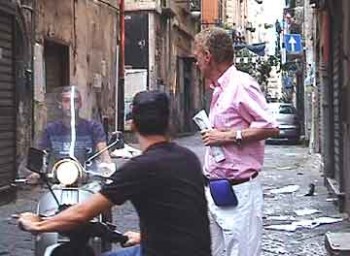
Closely related to Rolex theft, and possibly everything else going on in Naples, is the drug business. I remember a police officer we often met with in Barcelona ten years ago. He was Italian, and specialized in recognizing mafia bosses who’d had plastic surgery to change their appearance. He was intrigued with our work, and facilitated one of our important interviews with gypsy pickpockets in Barcelona. At the time, Bob and I didn’t understand why an Italian police officer with his knowledge-base would be working in Spain.
Now we read that a Camorra godfather and his henchman were captured in Madrid two weeks ago. “Neapolitan organised crime has created logistical bases in several major Spanish cities,” a Naples military police official said. They’re partnering with Colombian cartels in the cocaine business, stationed in Spain, Europe’s main welcome mat for drugs. Saviano, the author, says that “Spain is considered by many mafiosi as the best place to hide without interrupting their activities.” Seems that they were doing more than just hiding. Spain is wisening up though, having arrested many suspected Camorra members in the past few months, including a Camorra boss in Barcelona.
When police searched the hideouts of three arrested Comorra members near Naples a few months ago, they “found Carabinieri outfits and other disguises.” This first makes me think of “pseudo cops,” those who commit crimes while pretending to be police; then I think real cops, members of both the mafia and the police; and then I think dead cops. Of course there are endless uses for a police uniform if you’re a criminal.
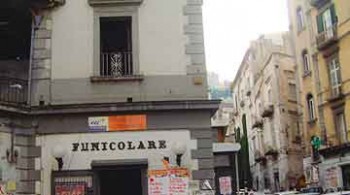
How is it all related? We’re not mafia experts; I’d hate for us to step on the wrong toes, ask the wrong question, or peek around the wrong corner. Frankly, research in Naples scares me. When it goes well, it’s extremely exciting. If it goes wrong, how wrong can it go?Â
Why is crime in Naples allowed to flourish? I used to wonder this. I used to be amazed that it went on and on. If Bob and I could see it, surely the police and politicians could see it, too. Now, of course, I realize that it’s an integral part of the economics and politics of the city. It’s not meant to go away. Hopefully the terrible violence of the past few years is a temporary symptom. But the theft, the graft, the drugs, extortion, money-laundering, palm-greasing, conning and scamming—they’re all art forms. They’re tradition. The way of life. It’s unique among modern countries. Something you might expect to find in the third world, or in the old days. An anachronism.
Naples has much to brag about. Just look at all the types of thievery: The pickpocket. The pacco man (bait-and-switch). The Rolex snatcher. The scippatori (thieves who snatch from the back of a speeding scooter). The borseggio (bag snatcher). All against a rich backdrop of warmth and welcome, including the thieves who invite us for lunch or coffee (and insist on paying) (after they try to steal our wallet). They all have heart, soul, pride, shamelessness, and bravado. Luciano, whom we’ve known since 1998, raised his kids on pickpocketing, and now has five or six grandchildren. Salvatore, the star of our Playboy shoot, is quick to show pictures of his babies.
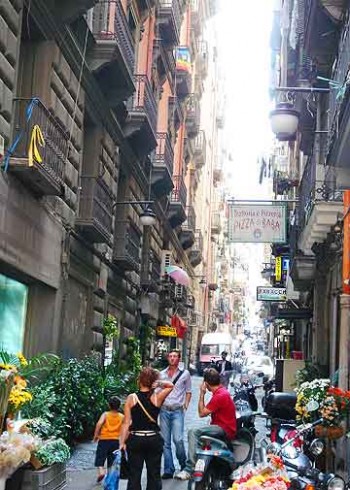
Danger is a big part of Naples. Worry. Concern. Fear. Contrasted with the pleasures: the ambiance of the place, the charm, the incredible food, the picturesque beauty of the old city, the gravel-voiced men in the coffee bars, not to mention the great coffee, lemon granita on the street, multiple weekend wedding couples out for photo sessions within sight of all the thieves I’ve mentioned.
Bob and I became intimately involved with the Camorra the moment we stepped among the pickpockets of Napoli. As I’ve hinted above, and as the linked articles state, the mob is everywhere and touches everything. The Camorra was aware of us from the moment we hit the streets, at some level or other. How high up our presence is known, who knows? How long it will be tolerated, who knows? But if the mob bosses don’t want us sniffing around anymore, we’ll find out. We plunge ahead, but we acknowledge that we’re in real mafia-country, investigating family business. We might pretend ignorance, but we can’t ignore the danger. When you work on mob turf, you cannot ignore the mob.
![]()

